Oregon is a state defined by its adventurous landscapes, inviting travelers to explore everything from the rugged Pacific coastline to towering mountain peaks and vast high-desert plains. This incredible diversity makes planning a trip a delightful challenge, offering a multitude of places to visit and unique things to do. To help you navigate this stunning state, we’ve curated a list of top attractions and destinations that capture the essence of Oregon’s natural beauty and vibrant culture, guiding you on Where To Go In Oregon for unforgettable experiences.
From ancient volcanic lakes nestled high in the Cascades to iconic sea stacks guarding sandy shores and bustling cities known for their unique character, Oregon presents a wealth of options. These diverse locales lead to memorable road trips and spontaneous excursions, revealing the state’s charm at every turn. Beyond its renowned natural wonders, Oregon’s urban centers like Portland offer a distinct blend of offbeat culture and welcoming communities, adding another layer to the travel experience.
Crater Lake National Park
Nestled in the Cascade Mountains of southwestern Oregon, Crater Lake National Park presents a landscape unlike anywhere else on Earth. What appears to be a massive crater is, in fact, an ancient caldera. It was formed over 7,000 years ago by the eruption and subsequent collapse of Mount Mazama, a towering volcano. Today, sheer lava cliffs ascend dramatically up to 2,000 feet, encircling a strikingly blue, incredibly deep lake that seems to touch the sky.
The most accessible way to experience the breathtaking beauty of Crater Lake is via Rim Drive, a scenic road that encircles the entire lake. This route typically opens for driving during the warmer months, from mid-July to mid-October. During the winter, the unplowed road transforms into a serene pathway utilized by snowshoers and cross-country skiers, offering a unique perspective of the snow-covered caldera.
Crater Lake National Park is a haven for hikers, boasting some of Oregon’s most spectacular trails. Paths like Watchman Peak provide stunning panoramic views of the caldera’s expanse. More moderate options originate from Rim Village, featuring paved sidewalks that offer accessible viewpoints. For those seeking greater adventure, extended hiking and backpacking opportunities, including sections of the country-spanning Pacific Crest Trail, are available away from the immediate rim area.
During the summer, visitors can access the lake’s surface at Cleetwood Cove, the only point allowing access. From here, boat cruises depart for Wizard Island, a cinder cone rising from the lake. Camping is also available within the park, with sites primarily located at the Mazama Campground, situated in Mazama Village, providing a convenient base for exploration.
Where To Go In Oregon – Must-See Destinations
Beyond the national park, southern Oregon offers abundant natural landscapes. Crater Lake is bordered by vast wilderness areas like Umpqua National Forest and Rogue River-Siskiyou National Forest. These forests feature hundreds of miles of additional hiking trails, inviting further exploration. Crater Lake also marks the northern terminus of the magnificent 500-mile Volcanic Legacy Scenic Byway, a route that traverses the state and connects numerous volcanic wonders.
What to Eat in Fort Worth – A Culinary Deep Dive
11 Must-Visit places to go in nevada for Your 2025 Trip
12 Unforgettable Fun Things to Do in Vegas for Couples
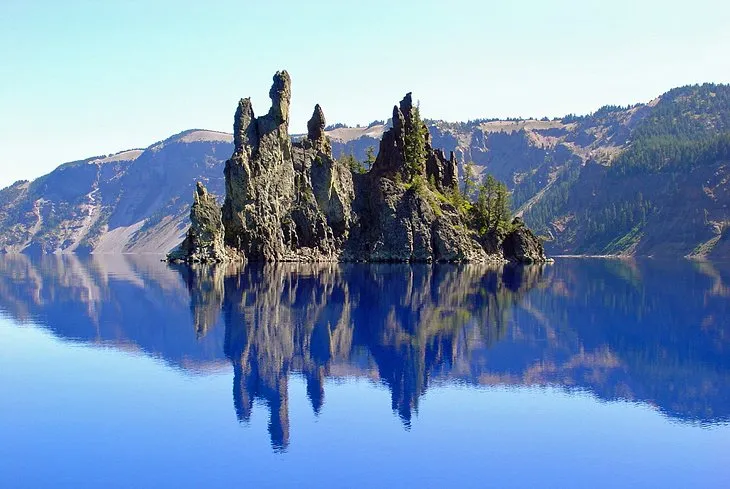 Panoramic view of the deep blue water at Crater Lake National Park
Panoramic view of the deep blue water at Crater Lake National Park
Columbia River Gorge National Scenic Area
The Columbia River Gorge National Scenic Area carves a dramatic path through the Cascade Range, following the mighty Columbia River. This stunning gorge forms the natural boundary between Oregon and Washington. Located just a short thirty-minute drive from Portland, it is famous for its spectacular viewpoints and an abundance of mesmerizing waterfalls, making it a prime destination for nature lovers and photographers alike.
Traveling along the Historic Columbia River Highway offers a more leisurely pace than the adjacent Interstate 84, allowing visitors to fully absorb the scenery. This historic corridor is dotted with numerous roadside attractions and viewpoints, making it a popular and picturesque route particularly favored by cyclists who enjoy its winding paths and frequent scenic pull-offs.
The tallest waterfall in Oregon, Multnomah Falls, stands as arguably the most iconic natural landmark within the Columbia River Gorge. This dazzling two-tier cascade attracts visitors year-round. The area around Multnomah Falls provides various hiking and biking trails, catering to different fitness levels, alongside convenient camping facilities for those wishing to extend their stay in this beautiful region.
The Multnomah Falls area is also home to the historic Multnomah Falls Lodge. Built in 1925, the lodge continues to welcome visitors, offering a popular spot for dining with a view or even staying overnight, adding a touch of historical charm to the natural experience. Multnomah Falls is one of the most popular day trips from Portland, easily accessible and immensely rewarding.
While Multnomah Falls is a must-see, it’s just one of many captivating waterfalls in the gorge. Another notable destination is Punchbowl Falls on Eagle Creek. Though not as tall as Multnomah Falls, Punchbowl Falls is incredibly scenic, offering a unique circular plunge pool that leaves a lasting impression on hikers who make the journey to see it.
Cannon Beach
Cannon Beach is a highly popular tourist destination situated on the northern Oregon coast. It features an expansive stretch of sandy beach punctuated by dramatic, jagged coastal rock formations that rise proudly from the Pacific. Haystack Rock is the most famous and largest of these sea stacks, serving as an unmistakable and constant presence during any visit to this vibrant coastal community.
Beyond its spectacular ocean scenery, Cannon Beach offers considerable cultural appeal. The town center boasts charming restaurants, unique boutique shops, and a selection of great hotels, creating a welcoming atmosphere. This blend of culture, local community flavor, and exceptional ocean access firmly establishes Cannon Beach’s reputation as one of the best small towns to visit along the diverse Oregon Coast.
North of Cannon Beach lies the enchanting Ecola State Park and Tillamook Head. This area encompasses both historically significant and scenically stunning landscapes perfect for exploration. It includes a section of the trail that follows the historic path of the Lewis and Clark Expedition, allowing visitors to walk in the footsteps of early explorers. The charming city of Seaside, located at the northern end of Ecola State Park, provides additional opportunities for family-friendly coastal travel and activities.
 Haystack Rock sea stack on Cannon Beach at low tide
Haystack Rock sea stack on Cannon Beach at low tide
Washington Park, Portland
The city of Portland is home to an array of delightful parks and gardens, yet none offer the same concentration of attractions as Washington Park. Located within its expansive grounds, you’ll find the world-renowned International Rose Test Garden situated near the impressive Portland Japanese Garden. Both gardens showcase exceptional horticultural artistry and expertise and are cherished favorites among gardening enthusiasts and casual visitors alike.
Washington Park also hosts several other significant attractions, including the Oregon Zoo, the sprawling Hoyt Arboretum, the educational World Forestry Center Discovery Museum, and a popular Rose Garden Children’s Playground. Even without these specific sites, the park itself is infused with the natural splendor of the Pacific Northwest, characterized by a dense landscape of native foliage and lush nature that provides an urban oasis.
Adjacent to Washington Park is the vast Forest Park, covering approximately 1,300 acres. Forest Park is home to some of the best hiking trails readily accessible from the Portland area, offering extensive opportunities for outdoor recreation within the city limits. Visitors should plan to allocate a full day to explore the multitude of attractions and natural areas available within this remarkable urban respite.
Parking can be challenging in certain areas of Washington Park, particularly near the International Rose Test Garden and the Portland Japanese Garden due to high visitor volume. To alleviate this, a free Washington Park shuttle service operates daily between April and September, facilitating movement within the park. Additionally, several public transit options connect downtown Portland directly to the park, providing convenient access without the need for personal vehicles.
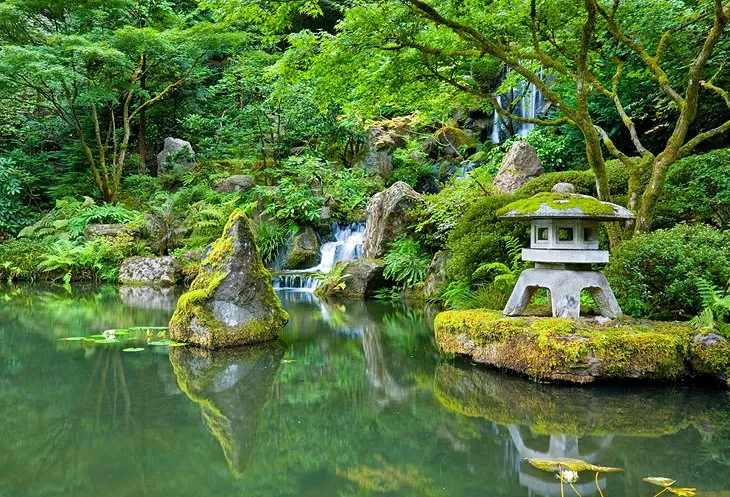 Tranquil scene at the Portland Japanese Garden
Tranquil scene at the Portland Japanese Garden
Mount Hood National Forest
Mount Hood stands as the highest mountain in Oregon, its peak reaching an impressive elevation of 11,239 feet. This immense stature makes the mountain an unmistakable natural landmark visible for miles in every direction across the state. On clear days, Mount Hood provides a spectacular and frequently photographed backdrop for the distant city of Portland to the east, adding a dramatic element to the urban skyline.
Mount Hood National Forest encompasses the entire mountain and extends across much of its surrounding flanks. This vast public land offers a wide range of adventurous activities throughout the year. The mountain slopes provide opportunities for downhill skiing and snowboarding at areas like Mount Hood Skibowl, picturesque hiking paths such as the renowned Timberline Trail, and scenic viewpoints easily accessible via the Mount Hood Scenic Loop drive. A section of the nation-spanning Pacific Crest Trail also traverses the mountain’s southwest flank.
The historic town of Government Camp and the iconic Timberline Lodge, famous for its architecture and history, are major attractions within this mountain landscape. The reflective waters of Trillium Lake offer a postcard-perfect setting and a fantastic view of the mountain. Extending from the peak, Mount Hood National Forest also includes numerous waterfalls and natural hot springs, providing varied options for exploration and relaxation.
 View of snow-capped Mount Hood towering over the landscape
View of snow-capped Mount Hood towering over the landscape
Bend
Bend is situated roughly in the geographical center of Oregon, bordered by a diverse mix of national forests, ancient volcanoes, and arid high desert plains. The city’s High Desert Museum offers insightful and engaging displays providing context and information about the surrounding arid regions’ unique ecology, history, and culture. It’s a great place to start to understand the local environment.
Popular activities in Bend include thrilling rafting trips on the Deschutes River, exploring the fascinating volcanic landscapes of Lava Butte, and visiting the expansive Newberry National Volcanic Monument. In winter, skiing and snowboarding at the large Mount Bachelor Ski Area are major draws. For a classic waterfall experience near the city, Tumalo Falls is easily accessible with just over a 10-mile drive from downtown Bend.
Located nearby, Smith Rock is internationally famous among rock climbers for its numerous bolted routes and its long history as a premier climbing destination. The area around Bend also offers extensive hiking trails, which are an excellent way to explore these scenic areas, and a network of mountain biking trails that add to the region’s reputation as an outdoor sports hub.
For a more relaxed exploration, the Cascade Lakes Scenic Byway provides a popular auto-touring route winding through the Deschutes National Forest. The drive passes by numerous pristine lakes, offers stunning views of surrounding mountains, and provides spectacular scenery throughout, with many convenient picnic spots and campsites available along the way for travelers to stop and enjoy the natural beauty.
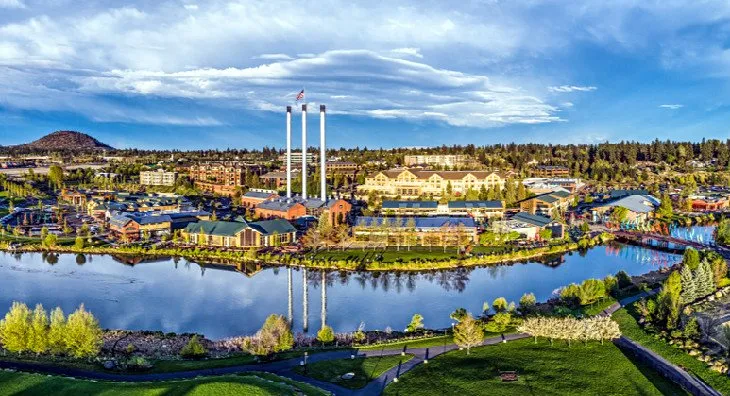 Skyline view of Bend, Oregon with mountains in the background
Skyline view of Bend, Oregon with mountains in the background
Astoria
Astoria is a charming seaside city blessed with inspiring natural surroundings, located in the far northwest corner of Oregon. It sits near the mouth of the Columbia River, just before it meets the vast Pacific Ocean. Although smaller in scale, Astoria is often compared to San Francisco due to its prominent seaside location, its hilly topography, and a vibrant downtown district pulsating with a strong sense of community and unique character.
Movie enthusiasts may recognize Astoria as the memorable backdrop for the 1980s cult-classic film, The Goonies. Visitors to Astoria can delve deeper into the city’s cinematic history, including The Goonies, at the Oregon Film Museum, which is creatively housed in the old Clatsop County Jail building, offering a unique blend of local history and film nostalgia.
Nearby, the Astoria Flavel House Museum provides valuable historical insight into the rich past of this well-aged city. Other top attractions in Astoria include the scenic Riverfront, which offers lovely walks and views of the busy harbor, and the iconic Astoria Column, a towering monument providing panoramic vistas of the surrounding area, including the river mouth and the Pacific Ocean.
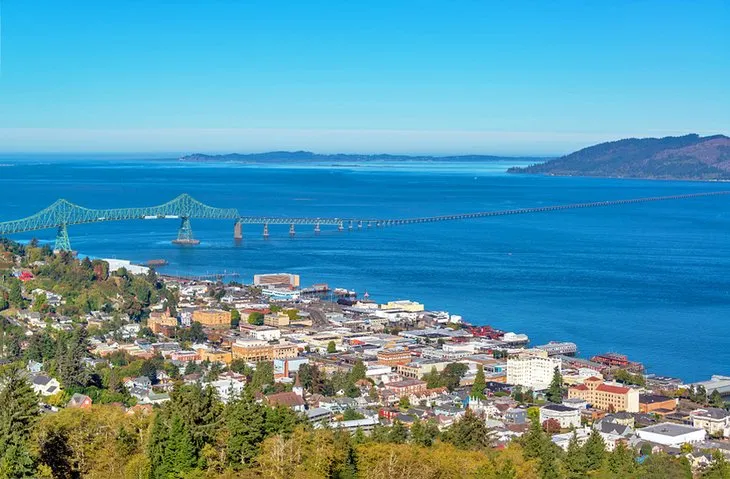 Elevated view overlooking the charming coastal city of Astoria
Elevated view overlooking the charming coastal city of Astoria
Hood River
The scenic city of Hood River is perched on the banks of the majestic Columbia River, located just over an hour’s drive east of Portland. It is renowned as a fantastic destination for both sightseeing and engaging in a wide variety of outdoor sports. Hood River is particularly well-known globally as a prime spot for kiteboarding and windsurfing, attracting enthusiasts from around the world to its windy riverfront.
Other popular activities in this adventurous region include extensive opportunities for hiking and biking on trails that wind through the surrounding forests and along the river, as well as numerous options for camping, allowing visitors to fully immerse themselves in the natural environment. The city is also gaining recognition for its burgeoning culinary scene, which often highlights fresh, seasonal ingredients sourced directly from the adjacent, fertile Hood River Valley.
Even more local tastes and agricultural experiences can be discovered by exploring the 35-mile Fruit Loop, a scenic driving route that winds from the city into the rich agricultural fields to the south. Visitors seeking less physically demanding activities can easily access the Historic Columbia River Scenic Byway from Hood River, which leads to a lush world filled with spectacular waterfalls.
The Mount Hood Railroad also departs from Hood River, offering a picturesque 17-mile journey to the town of Odell. Throughout the train ride, passengers are treated to stunning views of Mount Hood, providing a relaxing way to experience the scenery. Hood River successfully blends outdoor adventure, agricultural richness, and a growing food scene, making it a compelling destination.
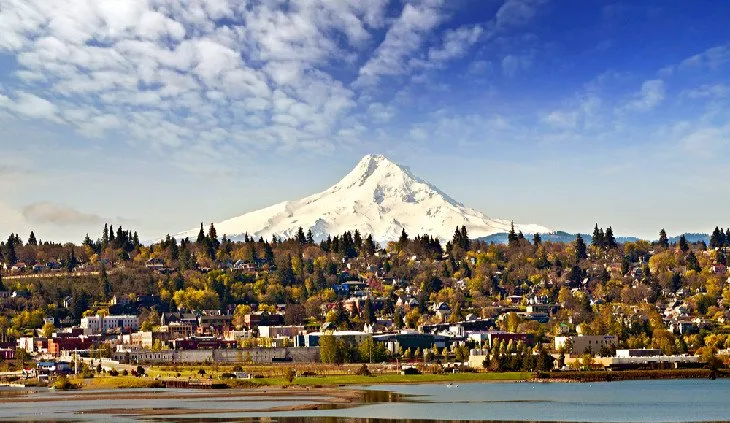 Waterfront view of Hood River with windsurfers on the Columbia River
Waterfront view of Hood River with windsurfers on the Columbia River
Samuel H. Boardman State Scenic Corridor, Brookings
The Samuel H. Boardman State Scenic Corridor is a breathtaking 12-mile linear park stretching along the southern Oregon coast between the towns of Brookings and Gold Beach. This stunning coastal corridor showcases some of the most spectacular oceanside scenery found anywhere in the state, characterized by dramatic cliffs, hidden coves, and striking rock formations.
Named in honor of the first Oregon Parks superintendent, the park is easily accessible directly from U.S. Highway 101, which winds its way along the coast. Numerous pull-offs and viewpoints are scattered along the entire length of the park, connecting various beaches, impressive rock formations, and highlighting the distinct natural beauty that uniquely defines this southern section of the Oregon coast. The challenging Oregon Coast Trail also spans the entire length of the park, offering a rigorous but incredibly rewarding day hike for experienced trekkers.
Most of the designated pull-offs within the state park lead to steep hiking trails. These paths often descend quickly, sometimes over rough or uneven terrain, to reach the secluded beaches and viewpoints below, offering a sense of discovery for those willing to make the effort. A few particularly popular stops along this scenic corridor include Arch Rock, known for its natural stone archway; Indian Sands, featuring wind-sculpted sand formations; and Lone Ranch Beach, which is widely considered one of the best beaches on the Oregon coast. This beautiful beach is noted for its easy accessibility, with convenient parking located nearby, making it a favored spot for visitors seeking a more relaxed coastal experience.
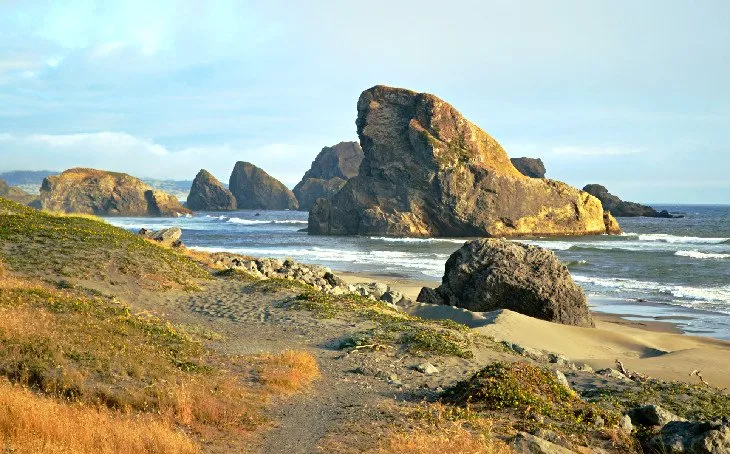 Rugged coastline and sea stacks at Samuel H. Boardman State Scenic Corridor
Rugged coastline and sea stacks at Samuel H. Boardman State Scenic Corridor
Smith Rock State Park, Terrebonne
Smith Rock State Park, located in central Oregon near the city of Bend, is recognized as an international destination for rock climbing enthusiasts. The state park boasts over 1,000 bolted sport climbing routes, meticulously set along the impressive walls of a stunning river canyon environment carved by the Crooked River. These routes cater to a wide range of skill levels, from beginner-friendly climbs to incredibly challenging routes requiring advanced technique and strength, and all necessitate proper climbing experience and gear.
However, Smith Rock is not exclusively for climbers; it’s also a popular outdoor playground for mountain bikers, hikers, and photographers who come to explore the park’s incredibly scenic surroundings. Thanks to the region’s high-desert weather system, climbing and exploring Smith Rock is often possible even in winter, frequently offering surprisingly mild, T-shirt conditions, a unique feature compared to other climbing destinations.
For one of the most recommended hiking experiences in the area, visitors should tackle the Misery Ridge trail. Despite its somewhat daunting name, this challenging hike provides truly stunning, panoramic views of the Crooked River winding through its deep canyon and the sheer cliff walls that define the park. The reward of the views more than compensates for the strenuous climb.
Smith Rock State Park offers camping facilities catering to different needs. It features an RV-exclusive campground for those traveling in recreational vehicles. Additionally, there is a walk-in area specifically designed for campers and climbers who prefer tent camping, providing a convenient and rustic basecamp right within the park’s dramatic landscape.
Official site: https://smithrock.com/
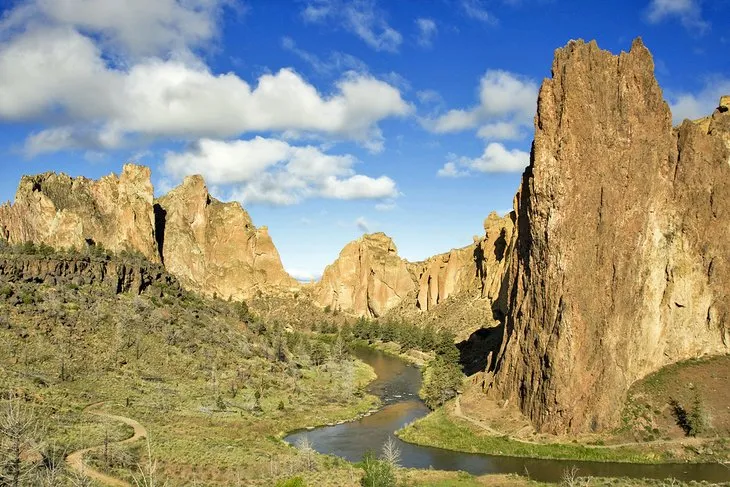 Rock climbers on the impressive cliffs at Smith Rock State Park
Rock climbers on the impressive cliffs at Smith Rock State Park
Oregon Shakespeare Festival, Ashland
The globally renowned Oregon Shakespeare Festival (OSF) takes place in the charming city of Ashland for a significant portion of the year. This esteemed non-profit theater production stages over 700 performances annually, presented across three distinct stages. One of these stages is the particularly beautiful Allen Elizabethan Theatre, an outdoor venue that adds a unique atmosphere to the performances. Attending any one of these productions offers a quintessential Southern Oregon cultural traveling experience.
With a festival season that typically runs from February through October, accompanied by considerable fanfare and attracting large audiences, the Oregon Shakespeare Festival plays a significant role in defining the community and cultural fabric of the surrounding city of Ashland. This influence is especially noticeable in the downtown district, where numerous Victorian-themed restaurants, shops, and galleries cater to festival-goers. Much of the audience naturally spills out of the theaters and onto these lively streets after a show, creating a vibrant and festive atmosphere.
Read More: Attractions & Things to Do in Ashland, Oregon
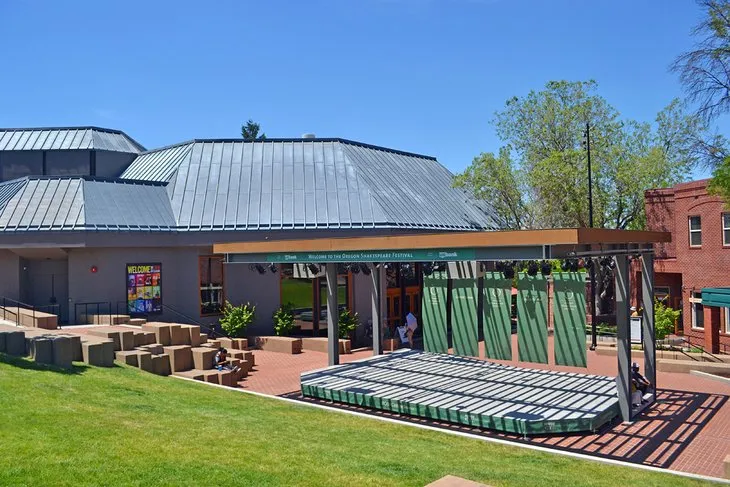 Outdoor stage and courtyard at the Oregon Shakespeare Festival in Ashland
Outdoor stage and courtyard at the Oregon Shakespeare Festival in Ashland
Newport
Newport, a city on the central Oregon coast, is filled with family-friendly attractions and perfectly blends stunning beach scenery with a distinct Victorian heritage. The Oregon Coast Aquarium and the Hatfield Marine Science Center are consistently popular places to visit, offering engaging exhibits on marine life and conservation. To the north of the city, the historic Yaquina Head Lighthouse stands as a prominent beacon of coastal beauty, perched dramatically on a headland.
Beautiful beaches are abundant in every direction from Newport, providing endless opportunities for coastal exploration and relaxation. The city’s historic Nye Beach certainly ranks among the top coastal spots, offering a classic Oregon coast experience. Other contenders for capturing stunning sunsets or enjoying sandy shores nearby include Agate Beach and South Beach State Park, each offering unique characteristics and scenic views.
Newport serves as an excellent base camp for exploring the wider central coast region and is particularly noted for its whale watching opportunities. The city’s busy bayfront faces Yaquina Bay, which serves as home to a large and active fishing fleet, adding to the authentic maritime atmosphere. Extending from the sheltered bay, the city’s wild Pacific beaches offer dramatic storm-surge rollers in the winter and unfiltered, spectacular sunsets year-round, providing a dynamic coastal experience.
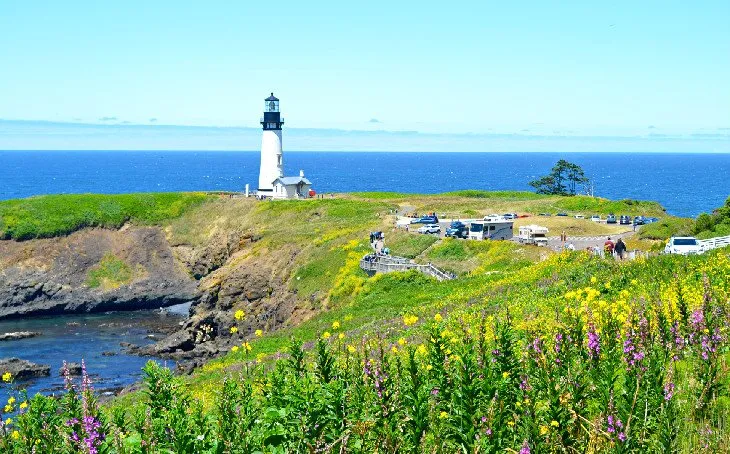 Yaquina Head Lighthouse on the Oregon coast near Newport
Yaquina Head Lighthouse on the Oregon coast near Newport
Sisters
Sisters is a delightful western-themed town situated on the west side of the Cascade Mountains, located approximately a scenic 30-minute drive from Bend. It’s smaller than Bend but offers a more concentrated, tourist-oriented community feel, particularly centered around its charming downtown shopping area. This downtown district features a distinct western charm, designed to evoke the look of the 1880s, with old-fashioned storefronts that now house a variety of modern retailers, boutiques, and eateries.
Sisters also functions as a major basecamp for outdoor adventures in the surrounding region. The landscapes immediately east of town are dominated by the vast Willamette and Deschutes National Forests, which together offer seemingly endless opportunities for adventure throughout the year, including hiking, biking, climbing, and more. Visitors can also embark on the scenic McKenzie Pass-Santiam Pass Scenic Byway, which starts near Sisters and offers one of the best automobile loops in Oregon, traversing stunning mountain and forest landscapes.
Read More: Things to Do in Sisters, Oregon
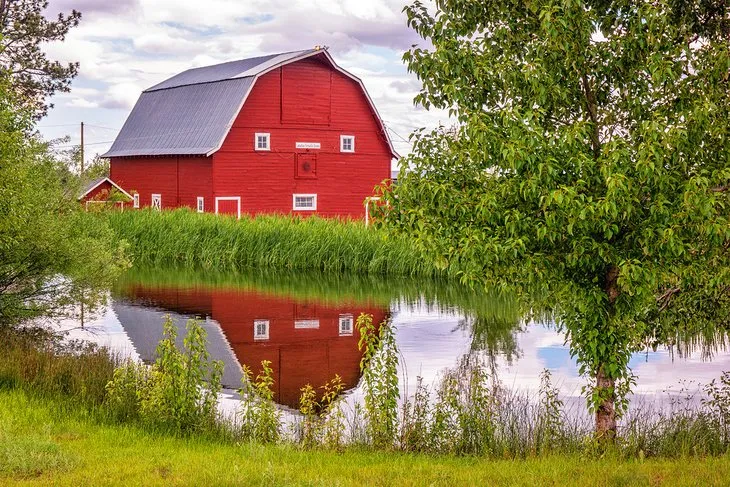 Rustic barn with mountains in the distance near Sisters, Oregon
Rustic barn with mountains in the distance near Sisters, Oregon
Silver Falls State Park, Sublimity
Silver Falls State Park is located approximately thirty minutes east of Salem, the state capital of Oregon. It is widely regarded as showcasing perhaps the most dazzling display of waterfalls found anywhere in the country within a single park. The park is home to the nationally recognized Trail of Ten Falls, a moderate hiking path that offers an incredible tour past, and often behind, many of the area’s stunning water attractions.
This true jewel of the Oregon State Park system provides hikers with the unique and exciting perspective of walking behind the curtain of several waterfalls, an experience that is both visually spectacular and refreshingly immersive. One of the most notable of these waterfall tunnels allows visitors to walk behind the largest cascade in the area and one of the best waterfalls in Oregon, the truly stunning South Falls, offering a truly memorable moment.
Visitors who wish to see the signature South Falls without embarking on the entire Trail of Ten Falls don’t have to travel far. The adjacent South Falls Day-Use Area is conveniently located nearby, providing easy access to the waterfall along with essential visitor amenities such as parking, picnic tables, and restrooms, making it a popular spot for shorter visits.
Address: 20024 Silver Falls Highway Southeast, Sublimity, Oregon
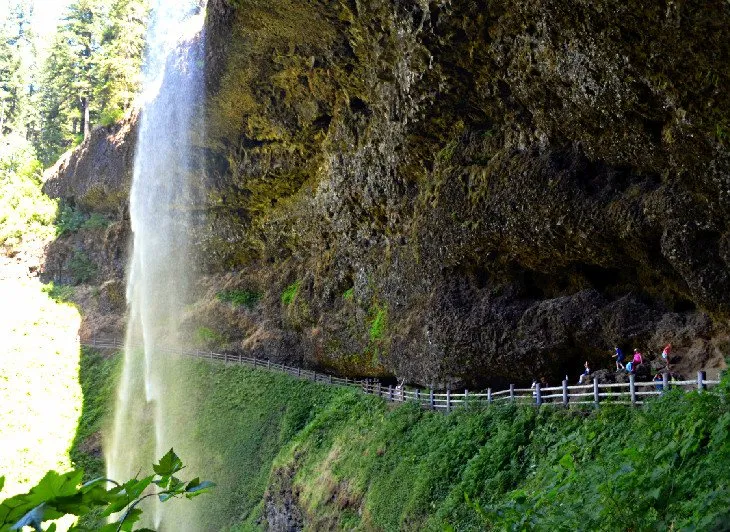 Impressive South Falls waterfall with a trail passing behind it
Impressive South Falls waterfall with a trail passing behind it
Depoe Bay
Depoe Bay is a charming seaside town that offers a truly stunning overlook of the vast Pacific Ocean from its vantage points. With its main street perched directly on the side of a cliff, the town easily lives up to its well-earned reputation as the “Whale Watching Capital of the Oregon Coast.” The Depoe Bay Whale Watching Center is an excellent first stop for visitors seeking information and tips on how to spot the massive gray whales that frequent the coastline throughout much of the year.
Alongside the constant presence of ocean sounds and breathtaking vistas presented along the entire western edge of the town, Depoe Bay fully caters to an authentic Oregon coast vacation experience. Local taffy shops, selling a sweet coastal treat, and fresh seafood restaurants line the charming Main Street. Adjacent to the street is the unique World’s Smallest Harbor, where commercial fishing trips and whale watching tours depart, encouraging visitors to embark on a day of adventure out on the water.
Depoe Bay also provides easy access to explore a particularly stunning section of the Oregon coast. Several public access points are dotted along the elevated coastline near Depoe Bay, offering spectacular views, especially during sunset. Iconic nearby areas like the fascinating Devil’s Punchbowl and the dramatic Yaquina Head are within a quick and convenient drive from Depoe Bay via Highway 101, allowing for further exploration of the coast’s natural wonders.
Read More: Things to Do in Depoe Bay
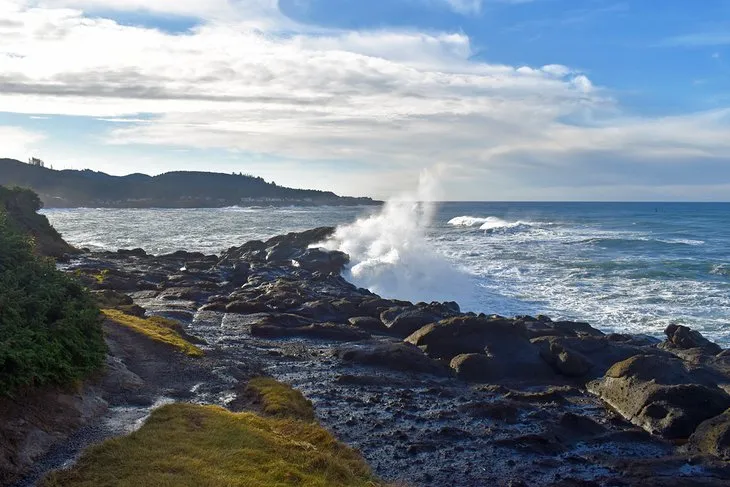 Coastal view of Depoe Bay, known as the whale watching capital
Coastal view of Depoe Bay, known as the whale watching capital
Newberry National Volcanic Monument
The Newberry Volcanic Monument offers a plethora of truly unique and fascinating scenery to explore within the vast Deschutes National Forest in Central Oregon. The monument is centered around the impressive Newberry Caldera and encompasses the area surrounding a massive 1,200-square-mile volcano, one of the largest in the Cascade Range. An excellent starting point for visiting the monument is the Lava Lands Visitor Center, where you can learn more about the geological history and ongoing thermal activity of this remarkable area.
Popular activities within Newberry National Volcanic Monument include bicycling on scenic trails, hiking through varied landscapes, and boating on the monument’s lakes. One of the best campgrounds in Oregon is located within Newberry; those fortunate enough to secure a reservation at the popular Little Crater Campground have immediate, convenient access to the welcoming, clear waters of Paulina Lake, perfect for swimming and relaxation.
Several scenic hot springs can be found dug into the shoreline of Paulina Lake, offering a unique opportunity for a warm soak in a natural setting. From the campground, this thermal area is accessible either by taking a boat ride across the lake or by embarking on a moderate three-mile round trip hike along an undulating trail that follows the lakeshore, providing scenic views along the way to reach the hot springs on foot.
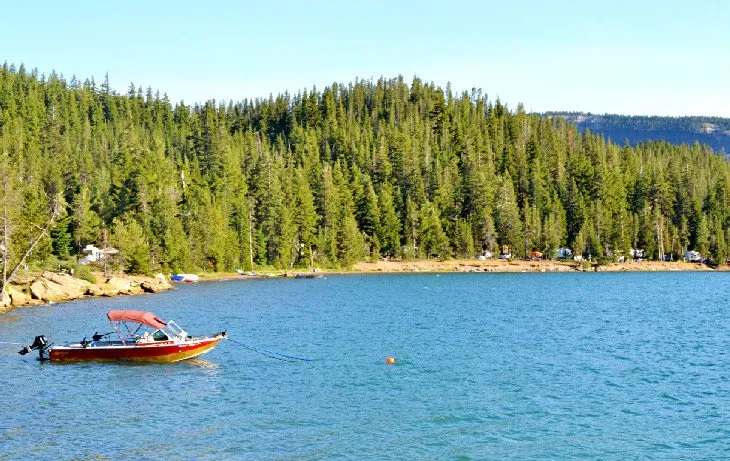 Camping area near Paulina Lake in Newberry National Volcanic Monument
Camping area near Paulina Lake in Newberry National Volcanic Monument
Klamath Falls
Klamath Falls serves as a primary base camp for launching adventures throughout Southern Oregon. The town is one of several notable stops along the state-crossing Volcanic Legacy Scenic Byway, a designated bucket-list highway that connects numerous volcanic and natural attractions. Crater Lake National Park, a major highlight of the byway, is conveniently located just 90 minutes north of Klamath Falls, while Lava Beds National Monument is less than 60 minutes to the south.
Beyond its proximity to these significant natural attractions, the city of Klamath Falls itself offers several appealing attractions and things to do for visitors. The town is blessed with abundant sunshine throughout much of the year, making outdoor activities particularly enjoyable. Places like Moore Park and the scenic Link River Trail provide plenty of space to explore the outdoors right within or near the city limits, perfect for walks and enjoying the local environment.
For cultural appeal, head to Klamath Falls’ downtown district, where a blend of historical architecture and modern tastes creates a fun visiting experience. Surrounding the downtown area, a collection of Klamath County Museums offers valuable insight into the rich history, culture, and natural heritage of the region, providing a deeper understanding of the area’s past and present.
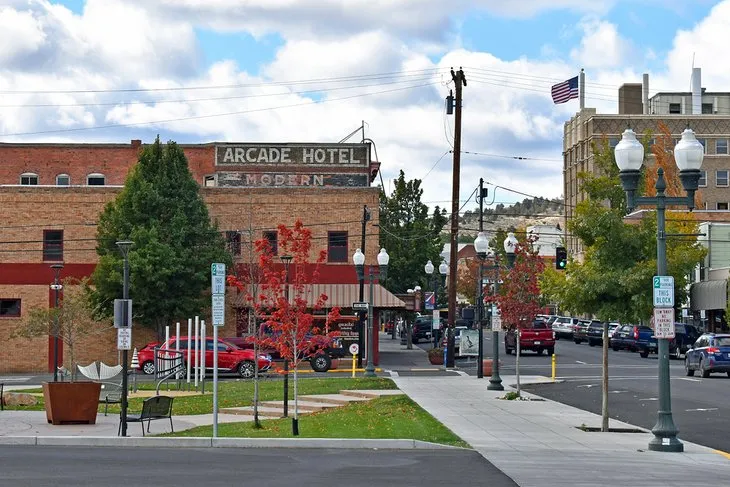 View of the city of Klamath Falls in Southern Oregon
View of the city of Klamath Falls in Southern Oregon
Oregon Dunes National Recreation Area
The impressive dune landscape of the Oregon Dunes National Recreation Area commences south of the town of Florence and stretches dramatically along the Pacific Coast for approximately 40 miles before reaching Coos Bay. This unique National Recreation Area is situated within the Siuslaw National Forest, located near other popular scenic attractions along the coast, such as the dramatic Cape Perpetua and the historic Heceta Head Lighthouse.
These miles of vast, shifting sand dunes are bordered by the ocean on one side and several pockets of coastal forests on the other, offering extensive space to explore either on foot or via off-highway vehicles (OHVs). Popular destinations within the dunes area include the expansive Umpqua Dunes area near Winchester Bay, a favored spot for OHV enthusiasts, and the dedicated sandboarding destination known as Sand Master Park in Florence, offering a unique board sport experience on the sand.
For visitors looking for a great place to set up camp, either in a tent or an RV, Jessie M. Honeyman Memorial State Park is conveniently located south of Florence and is considered one of the best campgrounds on the Oregon coast. It provides popular access points directly into the sand dunes and includes dedicated staging areas for both horses and off-road vehicles, making it a prime spot for dune adventures. Visitors exploring the dunes should remain aware of potential restrictions put in place to protect the habitat of the threatened snowy plover, a small shorebird.
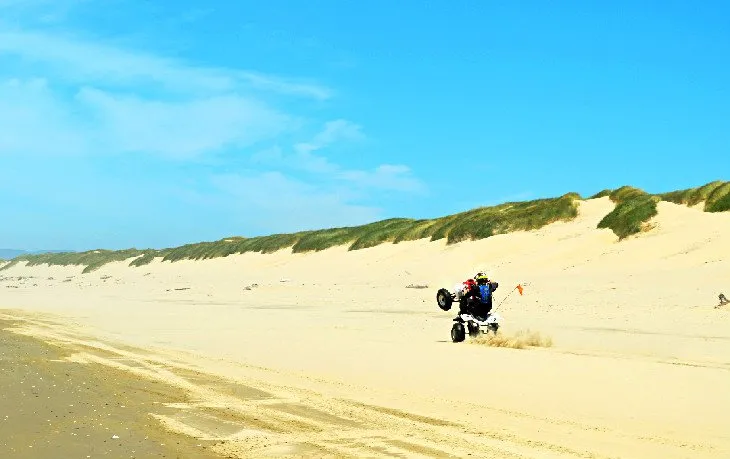 Off-highway vehicle rider on the vast sand dunes of Oregon Dunes National Recreation Area
Off-highway vehicle rider on the vast sand dunes of Oregon Dunes National Recreation Area
Hells Canyon National Recreation Area
Hells Canyon holds the distinction of being the deepest river canyon in the United States. This incredibly rugged and dramatic canyon is located in the extreme northeast corner of the state, straddling the border with Idaho. The area is managed as part of the vast Wallowa-Whitman National Forest, adding to its protected wilderness status. This remote and largely inaccessible landscape offers significant opportunities for the adventurous traveler seeking challenging outdoor excursions like multi-day rafting trips or demanding backpacking journeys.
The Wild and Scenic Snake River flows powerfully at the bottom of the canyon and is a major bucket-list destination for experienced whitewater boaters seeking thrilling rapids. Other popular activities available within the Hells Canyon area include nature photography, wildlife spotting (with chances to see bighorn sheep, elk, and various bird species), fishing in the river and its tributaries, and extensive hiking opportunities. The challenging Western Rim National Recreation Trail traverses the Oregon side of the canyon, providing spectacular views for dedicated hikers and backpackers who undertake the trek.
For those traveling by car, the Hells Canyon National Scenic Byway offers a less strenuous way to experience the periphery of this remote area. The byway departs from Baker City and La Grande, with side trips available to viewpoints overlooking Hells Canyon Dam and other scenic vistas, providing glimpses into the scale of the canyon from above without requiring a descent into its depths.
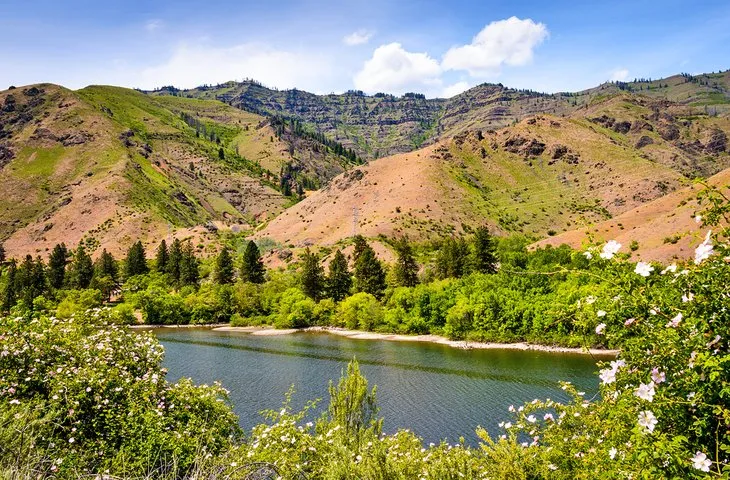 Dramatic view of the deep Hells Canyon
Dramatic view of the deep Hells Canyon
Oregon Coast Trail
The Oregon Coast Trail (OCT) is an epic footpath that stretches for over 360 miles along the entire western edge of Oregon, offering hikers an unparalleled way to experience the sights, sounds, and top attractions of the diverse Oregon coast. Undertaking the entire trail is a major endeavor, and most people choose to tackle the Oregon Coast Trail in segments, typically completing three to five days at a time and covering distances ranging from 20 to 30 miles, allowing for repeated visits to explore different sections.
Several campgrounds are conveniently located along the trail, many within state parks. These parks often have designated hiker/biker sites set aside specifically for those traveling on foot or by bicycle. Reservations typically are not needed for these sites, though it’s required that everyone arriving at these specific sites does so via muscle-powered transportation, encouraging sustainable travel along the coast.
While the trail primarily follows the beaches, hikers on the OCT must also navigate through forested headlands, catch boat rides or arrange alternative transportation to cross estuaries, and follow along the shoulder of U.S. Highway 101 for certain portions of the trek where beach access is not feasible or safe. Thorough research and planning are essential before embarking on any section of the OCT to solidify logistics such as available campgrounds, potential estuary crossings, and tide schedules.
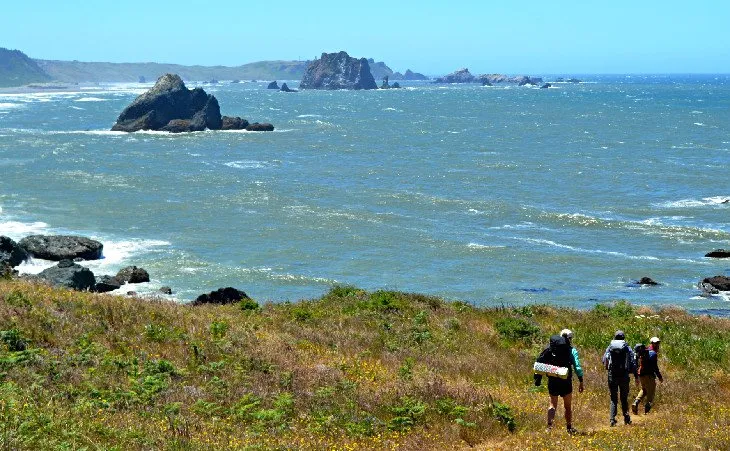 Hiking trail overlooking the rugged Oregon coastline
Hiking trail overlooking the rugged Oregon coastline
Willamette National Forest
The expansive Willamette National Forest covers nearly 1.7 million acres, primarily situated on the western slopes of the picturesque Cascade Mountains. This vast forest contains spectacular and varied scenery, including several prominent volcanoes, numerous mountains peaks, winding rivers, and some of the best natural hot springs found anywhere in Oregon, offering a range of recreational opportunities in a stunning setting.
Visitors can explore extensive trail systems winding through diverse ecosystems or head to specific attractions within the forest. Notable points of interest include the unique Dee Wright Observatory, a stone tower constructed atop McKenzie Pass offering panoramic views, and the impressive 280-foot Salt Creek Falls, a powerful waterfall easily accessible from a viewpoint. The famous Three Sisters Wilderness, a rugged and beautiful area popular with backpackers and climbers, is also accessible from within Willamette National Forest.
This region of the state is particularly dense with national forests, creating a massive interconnected natural playground. Directly to the east of Willamette National Forest, the Deschutes National Forest is equally popular for recreation, offering a complementary set of landscapes and activities, particularly in the high desert and volcanic areas. To the north, Mount Hood National Forest surrounds the impressive peak for which it is named, providing even more mountainous terrain and recreational opportunities.
 Powerful Salt Creek Falls waterfall in Willamette National Forest
Powerful Salt Creek Falls waterfall in Willamette National Forest
Willamette Heritage Center at The Mill, Salem
Salem is the state capital of Oregon, located centrally within the fertile and picturesque Willamette Valley. The city is home to a variety of attractions, including historic theaters, family-favorite carousels, and the Enchanted Forest theme park. Other top attractions in Salem include the scenic Riverfront City Park, a popular spot for recreation and events, the State Capitol building itself, and the historically significant Willamette Heritage Center.
The Willamette Heritage Center offers a fascinating glimpse into the life and industrialization of the Willamette Valley during the late 1800s. Spread across a five-acre campus, the center is anchored by the impressive Thomas Kay Woolen Mill, which dates back to 1895 and stands as a central feature. Alongside the large red brick mill structure, several other historic wooden buildings have been preserved and brought to life through engaging exhibits and knowledgeable interpretive guides, providing a comprehensive look at the region’s past industries and daily life.
Address: 1313 Mill Street Southeast, Salem, Oregon
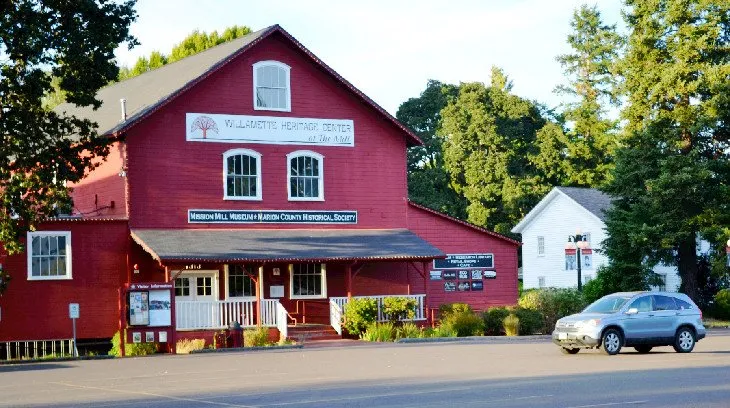 Historic buildings at the Willamette Heritage Center in Salem
Historic buildings at the Willamette Heritage Center in Salem
Jordan Schnitzer Museum of Art, Eugene
This distinctive, windowless museum in Eugene was thoughtfully designed specifically to protect its valuable art treasures from harmful light. The museum houses a wide-reaching collection that primarily features significant Asian artworks but also includes noteworthy pieces from America and Europe, offering a diverse range of artistic styles and historical periods for visitors to explore and appreciate.
Opened to the public in 1933, the museum is conveniently located on the campus of the University of Oregon, making it easily accessible for students and visitors alike. The university campus is also home to other interesting attractions, such as the engaging Museum of Natural and Cultural History and the historic track at Hayward Field, famous in the world of track and field sports, providing multiple points of interest in close proximity.
Guided tours of the museum are available to the public on the first Saturday of every month, offering a deeper insight into the collections and specific exhibits. These tours are included with the cost of admission, providing an excellent opportunity to learn more about the art and the museum’s history from an expert guide.
Address: 1430 Johnson Lane, Eugene, Oregon
Official site: http://jsma.uoregon.edu/
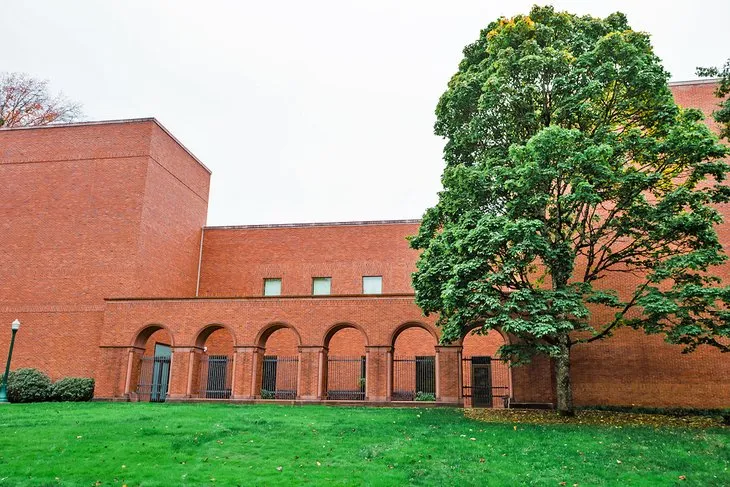 Exterior view of the Jordan Schnitzer Museum of Art in Eugene
Exterior view of the Jordan Schnitzer Museum of Art in Eugene
Oregon Caves National Monument and Preserve
This fascinating subterranean attraction is centered around a remarkable marble cave system, which is accessible to visitors only through guided tours led by National Park Service rangers. The NPS offers a variety of tour options designed to explore the cave’s unique geological formations. These range from accessible guided treks suitable for families and children to more adventurous “wild cave” expeditions that venture off the typical tourist path into more challenging sections of the cave system, catering to different levels of interest and physical ability.
Above the surface, the protected area of the monument and preserve offers a network of hiking trails that wind through beautiful old-growth coniferous forests, providing a contrasting natural experience to the underground exploration. The monument is situated at an elevation of approximately 4,000 feet within the rugged Siskiyou Mountains, contributing to its distinct flora and fauna. For those wishing to stay overnight, seventeen primitive campsites are available at the monument’s Cave Creek Campground, located about four miles from the main cave entrance, offering a rustic camping experience close to nature.
Address: 19000 Caves Highway, Cave Junction, Oregon
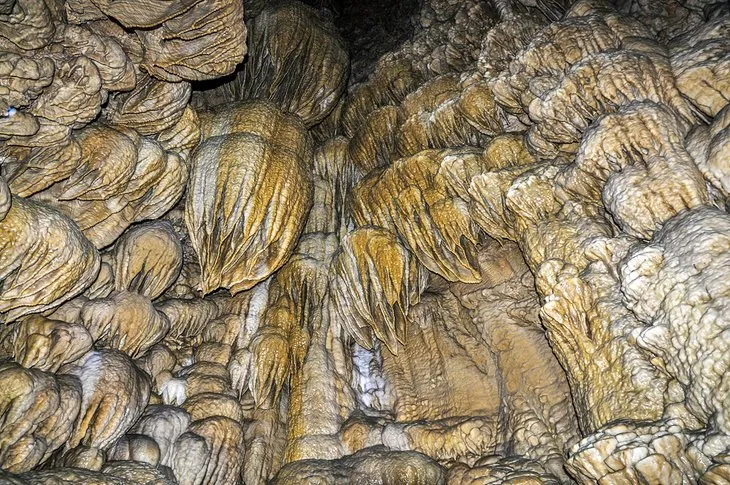 Entrance to the Oregon Caves National Monument
Entrance to the Oregon Caves National Monument
Medford
Medford holds the distinction of being the largest city in Southern Oregon and serves as a vibrant hot spot for both regional travel and vacations. It is considered the heart of the fertile Rogue River Valley, a designation that ties the city closely to both an agriculturally rich region known for its orchards and vineyards, and several natural playgrounds offering extensive outdoor recreation opportunities.
Outdoor adventures easily stemming from Medford include thrilling jet boat tours navigating the rapids of the Rogue River, offering an exciting way to experience the waterway, and challenging climbs to the top of the culturally significant Table Rock formations, which provide panoramic views of the valley. Prescott Park is a local favorite place to explore, encompassing one of the most prominent peaks closest to the city, Roxy Ann Peak, offering trails and natural beauty right at Medford’s doorstep.
Medford also serves as a significant hub for culture and commerce in Southern Oregon. Its larger population supports more extensive shopping malls and big-box retailers, providing commercial options. However, the downtown district, with its charming local shops lining the streets, is widely considered the best place to experience the authentic community flavor and unique character of Medford.
